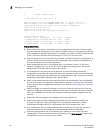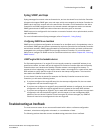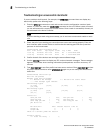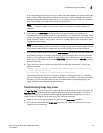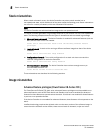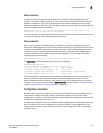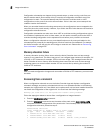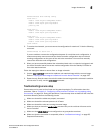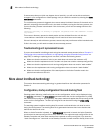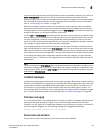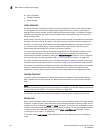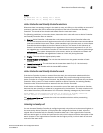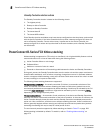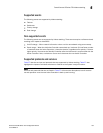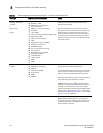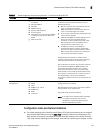
158 PowerConnect B-Series FCX Configuration Guide
53-1002266-01
More about IronStack technology
5
If secure-setup times out (this may happen due to inactivity), you will not be able to make any
changes in your configuration or stack topology until you restart the session by entering the stack
secure-setup command.
The unit discovery process is triggered when secure-setup is initiated. However, if the stack unit is
placed in a topology where another unit in the stack is already running the discovery process, the
current discovery process is terminated. If this is the case, you will see a message similar to the
following.
"Topology discovery is already in progress originated from <mac-address>. Please
try later."
This means a discovery process is already active and was initiated from the unit with the
<mac-address> mentioned in the message. You will need to re-issue secure-setup.
If there is already an active discovery process, secure-setup may not discover all the intended units.
If this is the case, you will need to restart the secure-setup process.
Troubleshooting unit replacement issues
If you are unsuccessful in building a stack using the automatic setup process (refer to “Scenario 2 -
Configuring a three-member IronStack in a ring topology using the automatic setup process” on
page 105), or adding or replacing a unit in a stack, consider the following issues:
• Make sure that the number of units in your stack does not exceed the maximum of 8
• Make sure that the replacement unit is a clean unit (does not contain a startup-config.txt file)
• Make sure that the replacement unit running configuration does not contain “stack enable”
• Make sure the replacement unit running configuration does not contain “stack disable”
• Make sure that the configurations of the stack ports on the Active Controller match the
physical connections to the unit
More about IronStack technology
This section discusses stacking technology in greater detail than the information presented in
Section 1.
Configuration, startup configuration files and stacking flash
Stacking system behavior is defined by the run time configuration, which can be displayed using
the show run command. The write memory command stores the run time configuration in a flash
file called startup-config.txt. During bootup, the system reads and applies the startup-config.txt file
to the run time configuration. The startup-config.txt file can be shown using the show config
command.
The stacking system installs a stacking.boot file on each unit that tells the unit what its role is
during the boot process. The stacking.boot file is generated whenever there is an election that
defines the roles for all units.
When an Active Controller is booted, or a write memory command is issued, the Active Controller
synchronizes its startup-config.txt file to every stack unit. The original startup-config.txt files in the
Standby Controller and other stack members are renamed to startup-config.old. If you issue the
“stack unconfigure me” command on the Standby Controller or stack member directly, these units



